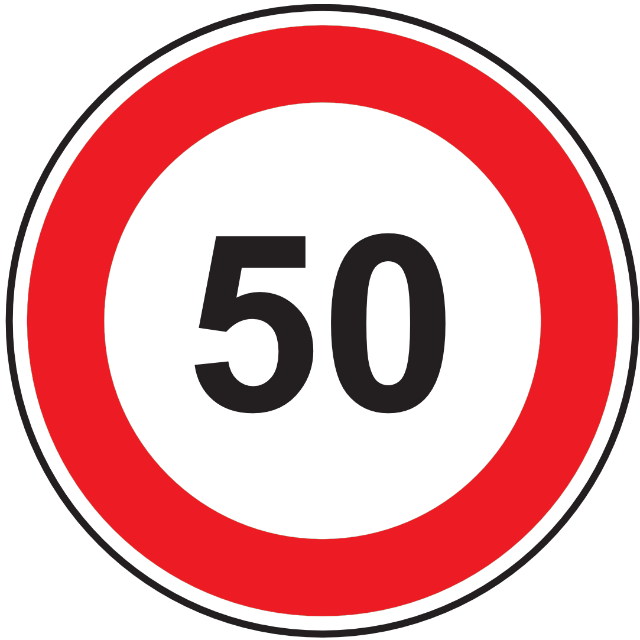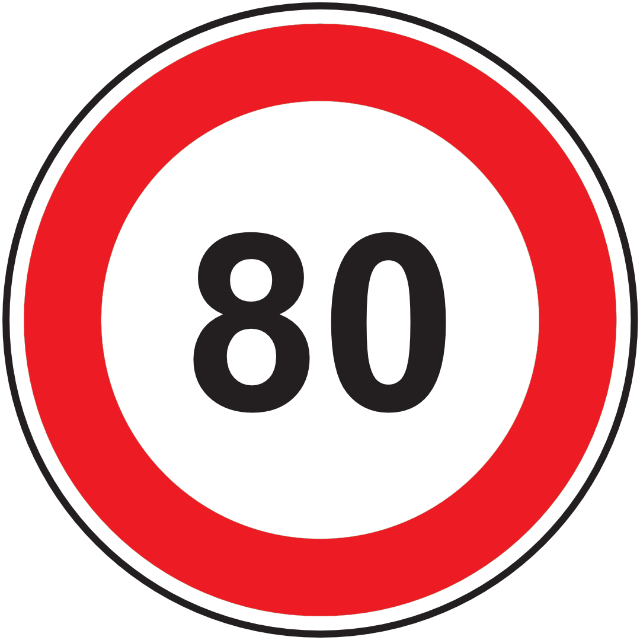Which rule are you interested in?
- Seat belts
- Traffic lights
- Speed limits
- Alcohol limits
- Influence of drugs
- Forbidden lane
- Safety helmet
- Mobile telephone
- Other specific rules
The use of seat belts and child restraint systems is MANDATORY (Directive 91/671/EEC as amended). Exemptions for mandatory use:
|
No information |
Motorcycles
Vehicles below 3.5 t
Standard speed limits (unless otherwise stated by traffic signs) [km/h]
 | Urban roads |
 | Non-urban roads |
 | Motorways/expressways |
Passenger cars & vans
Vehicles below 3.5 t
Standard speed limits (unless otherwise stated by traffic signs) [km/h]
 | Urban roads |
 | Non-urban roads |
 | Motorways/expressways |
Passenger cars & vans with trailers
Vehicles below 3.5 t
Standard speed limits (unless otherwise stated by traffic signs) [km/h]
 | Urban roads |
 | Non-urban roads |
 | Motorways/expressways |
Heavy goods vehicles
over 3.5 t
Standard speed limits (unless otherwise stated by traffic signs) [km/h]
 | Urban roads |
 | Non-urban roads |
 | Motorways/expressways |
Buses
Standard speed limits (unless otherwise stated by traffic signs) [km/h]
 | Urban roads |
 | Non-urban roads |
 | Motorways/expressways |
General
| The standard speed limit is the speed limit that is often used on given type of road. |
| 0,2 g/l Standard drivers | |
| 0,2 g/l Novice drivers | |
| 0,2 g/l Professional drivers | |
Alcohol consumption is forbidden during working hours and 8 hours before work for professional drivers. |
Forbidden drugsImpairment limits comparable to a blood alcohol concentration (BAC) of 0.02%, are defined for 20 psychotropic drugs, including the most prevalent benzodiazepines, cannabis, GHB, hallucinogens and opioids. Limits for graded sanctions, representing drug concentrations in blood likely to induce impairment comparable to BACs of 0.05% and 0.12%, are defined for 13 of the 20 substances. Alprazolam (3 ng/ml) Clonazepam (1.3 ng/ml) Diazepam (57 ng/ml) Fenazepam (1.8 ng/ml) Flunitrazepam (1.6 ng/ml) Nitrazepam (17 ng/ml) Oxazepam (172 ng/ml) Zolpidem (31 ng/ml) Zopiclone (12 ng/ml) THC (1.3 ng/ml) Amphetamine (41 ng/ml) Cocaine (24 ng/ml) MDMA (48 ng/ml) Methamphetamine (45 ng/ml) GHB (10 300 ng/ml) Ketamine (55 ng/ml) LSD (1 ng/ml) Buprenorphine (0.9 ng/ml) Methadone (25 ng/ml) Morphine (9 ng/ml) |
There are lanes reserved for various types of vehicles, as specified by road signs. Drivers must use the lane specified for the vehicle they are driving. |
| Bicycles | |
| Mopeds | |
| Motorcycles with/without a sidecar | |
| Light and heavy tricycles | |
| Light and heavy quadricycles |
 | Drivers may not use their mobile phone without a hand-free set |
 | Drivers may use their mobile phone with a hand-free set |
| Mandatory day time running light | |
| Safety equipment for carsWarning triangle Reflective vest in the car Fire extinguisher – only in buses | |
| Mandatory use of winter tyres Winter tyres are mandatory for heavy goods vehicles beyond 3.5 tons from 15 November to 31 March. Heavy goods vehicles beyond 3,5 tons are also required to be equipped with tyres with a tread depth of at least 5 mm and a sufficient number of snow chains. Studded tyres may only be used between 1 November and the first Monday after Easter Monday. In the counties of Nordland, Troms and Finnmark, studded tyres may be used from 16 October up to and including 30 April. There are no such date restrictions when it comes to non-studded winter tyres. The vehicle must have winter tyres (studded or non-studded), chains or similar also outside of the periods mentioned above if this is necessary in order to ensure sufficient road grip. If snow or ice can be expected on the roads, the vehicle must carry chains regardless of the time of year. |
Disclaimer
This content on road safety and traffic rules is provided by the national authorities according to Article 8(1) of Directive (EU) 2015/413/EU. The European Commission does not assume liability for this content or its accuracy. For the most accurate and up-to-date information check national websites, where you can also find information on other national rules covering time-based charges (vignettes), emission stickers and road tolls.
